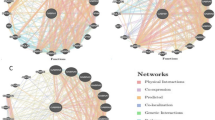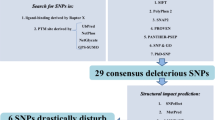Abstract
The aim of our study is to identify probable deleterious genetic variations that can alter the expression and the function of the CHRNA3 gene using in silico methods. Of the 2305 SNPs identified in the CHRNA3 gene, 115 were found to be non-synonymous and 12 and 15 nsSNPs were found to be in the 5′ and 3′ UTRs, respectively. Further, out of the 115 nsSNPs investigated, eight were predicted to be deleterious by both SIFT and PredictSNP servers. The major mutations predicted to affect the structure of the protein are phenylalanine to valine (Y43V) and lysine to asparagine (K216N) as shown by the trajectory run in molecular dynamics studies. The random transition of the protein structures over the simulation period caused by these mutations hints at how the native state is distorted which could lead to the loss of structural stability and functionality of the nicotinic acetylcholine receptors subunit α-3 protein. Based on this work, we propose that the nsSNP with SNP id of rs75495285 and rs76821682 will have comparatively more deleterious effects than the other predicted mutations in destabilizing the protein structure.






Similar content being viewed by others
References
Amos CI et al (2010) Nicotinic acetylcholine receptor region on chromosome 15q25 and lung cancer risk among African Americans: a case-control study. J Natl Cancer Inst 102:1199–1205
Bendl J et al (2014) PredictSNP: robust and accurate consensus classifier for prediction of disease-related mutations. PLoS Comput Biol 10:e1003440
Egleton RD, Brown KC, Dasgupta P (2008) Nicotinic acetylcholine receptors in cancer: multiple roles in proliferation and inhibition of apoptosis. Trends Pharmacol Sci 29:151–158
Hung RJ et al (2008) A susceptibility locus for lung cancer maps to nicotinic acetylcholine receptor subunit genes on 15q25. Nature 452:633–637
Jia M et al (2014) Computational analysis of functional single nucleotide polymorphisms associated with the CYP11B2 gene. PLoS One 9:e104311
Matsumoto Y et al (2013) Crystal structure of a complex of human chymase with its benzimidazole derived inhibitor. J Synchrotron Radiat 20:914–918
McMenamin SB et al (2010) Adoption of policies to treat tobacco dependence in U.S. medical groups. Am J Prev Med 39:449–456
Novikov GV, Sivozhelezov VS, Shaitan KV (2013) Investigation of the conformational dynamics of the adenosine A2A receptor by means of molecular dynamics simulation. Biofizika 58:618–634
Roman J, Koval M (2009) Control of lung epithelial growth by a nicotinic acetylcholine receptor: the other side of the coin. Am J Pathol 175:1799–1801
Salim EI, Jazieh AR, Moore MA (2011) Lung cancer incidence in the arab league countries: risk factors and control. Asian Pac J Cancer Prev 12:17–34
Shahzad K et al (2013) A structured-based model for the decreased activity of Ala222Val and Glu429Ala methylenetetrahydrofolate reductase (MTHFR) mutants. Bioinformation 9:929–936
Shen B et al (2012) Correlation between polymorphisms of nicotine acetylcholine acceptor subunit CHRNA3 and lung cancer susceptibility. Mol Med Rep 6:1389–1392
Shen B et al (2013) CHRNA5 polymorphism and susceptibility to lung cancer in a Chinese population. Braz J Med Biol Res 46:79–84
Singh S, Pillai S, Chellappan S (2011) Nicotinic acetylcholine receptor signaling in tumor growth and metastasis. J Oncol 2011:456743
Thorgeirsson TE et al (2008) A variant associated with nicotine dependence, lung cancer and peripheral arterial disease. Nature 452:638–642
Xu J et al (2013) Genetic variation in a microRNA-502 minding site in SET8 gene confers clinical outcome of non-small cell lung cancer in a Chinese population. PLoS One 8:e77024
Acknowledgments
The authors wish to thank the Management, Principal, Director and Head of the Department of the Siddaganga Institute of Technology, Tumkur, and KLE Dr. MSS CET, Belgaum. The authors also thank KBITS for providing computational resources to carry out this study.
Conflict of interest
No conflict of interest.
Author information
Authors and Affiliations
Corresponding author
Rights and permissions
About this article
Cite this article
Chandramohan, V., Nagaraju, N., Rathod, S. et al. Identification of Deleterious SNPs and Their Effects on Structural Level in CHRNA3 Gene. Biochem Genet 53, 159–168 (2015). https://doi.org/10.1007/s10528-015-9676-y
Received:
Accepted:
Published:
Issue Date:
DOI: https://doi.org/10.1007/s10528-015-9676-y




